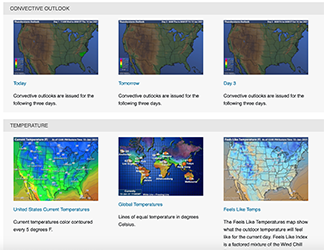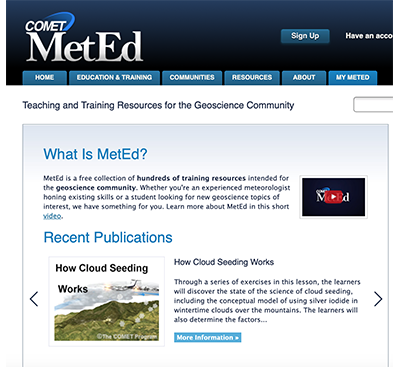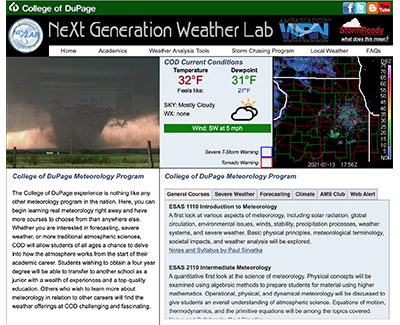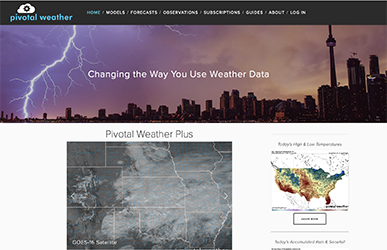How to Get Started as an Amateur Weather Observer: Educational Websites
- By Ben May, Board Director of the National Weather Association Foundation
- Feb 11, 2021
“There is no such thing as bad weather, only different kinds of good weather”
-John Ruskin
Those of us who believe the truth of Ruskin’s words may not see all weather phenomena as good, but we do revel in it all, fascinated by the atmosphere’s daily march wherever we live. My own journey began many years ago on the plains of Oklahoma and continues in Orlando, Florida.
This short series on becoming an amateur weather observer is to share a bit of my journey and, hopefully, offer some guidance whether you just want to look out the window or become a serious amateur creating your own forecasts from computer programs with your handheld mobile device loaded with weather apps. I begin with the different profiles of weather observers and key websites for weather education.
Profile of the Weather Amateur
I divide the weather amateur into three categories based on your interest and the amount of time you would like to devote to the depth of your interest: Basic, Intermediate and Advanced.
Basic
You have a cursory interest. You might watch the local news for the weather forecast, possibly tune in to the Weather Channel if there’s some heavy weather coming your way, reading the daily forecast from your mobile device.
Intermediate
You probably have a bit of excitement when you watch the local forecast and wonder how it all comes together. You may have one or two radar apps so you can follow storms in your area. You’d like to have a better general understanding of basic weather phenomena and maybe make some observations for fun; even consider purchasing weather instruments for your location, possibly making daily observations.
Advanced
You have been at the intermediate level for a few years and really want to jump in as far as you can without becoming a meteorologist or a storm chaser, but, perhaps, participating as a Cooperative Weather Observer for NOAA or CoCoRaHS (Community Collaborative Rain, Hail and Snow Network). You review weather maps daily with more than a few weather apps on your mobile device. You have your own weather instruments, possibly making daily observations. You want to move up to the next level so that you can make some serious local forecasts. You want to ‘crack a few books’ on meteorology or maybe even download forecasting programs you can customize to your location.
Where Do I Start?
Educate Yourself First...Just a Bit
 The good news is that no matter what level of observer you are, there is an explosion of weather information available to the public and for anyone who wants to jump in with both feet. The challenging news is that there is so much information that it’s difficult to know where to start. You can just begin where you are by following the daily weather surface map and see where it takes you; learning every feature on the map from fronts to Highs and Lows. A nice website to start with is Intellicast. This is a great site for every category of weather enthusiast. Owned by The Weather Channel, this site has a set of good basic weather maps to get some familiarity with the daily progression of weather.
The good news is that no matter what level of observer you are, there is an explosion of weather information available to the public and for anyone who wants to jump in with both feet. The challenging news is that there is so much information that it’s difficult to know where to start. You can just begin where you are by following the daily weather surface map and see where it takes you; learning every feature on the map from fronts to Highs and Lows. A nice website to start with is Intellicast. This is a great site for every category of weather enthusiast. Owned by The Weather Channel, this site has a set of good basic weather maps to get some familiarity with the daily progression of weather.
 On the government side of things, the National Weather Service website is a ‘cavernous’ goldmine of information if you have the time and interest; providing a working daily platform for all three levels of amateur. But you can start very simply by going to the NWS website, putting in your city or zip code to get started and going on from there to the state, regional and national weather maps. This is one of the best places to start because it’s in your ‘backyard.’ You will see a number of spin-off sites: local radar, any number and type of observations as well as local forecasts. The best source of information from your local NWS office is known as the scientific discussion. This is a primer for learning about the forecast for your state in general, and also for particular geographic areas. You can learn quite a bit by just dissecting these discussions word for word, even using the NWS glossary that is available with the discussion. The local forecaster usually has years of experience so you can ‘tune in’ to the ‘quirks’ of your area as explained by the forecaster. You can also get any warnings or upcoming weather events.
On the government side of things, the National Weather Service website is a ‘cavernous’ goldmine of information if you have the time and interest; providing a working daily platform for all three levels of amateur. But you can start very simply by going to the NWS website, putting in your city or zip code to get started and going on from there to the state, regional and national weather maps. This is one of the best places to start because it’s in your ‘backyard.’ You will see a number of spin-off sites: local radar, any number and type of observations as well as local forecasts. The best source of information from your local NWS office is known as the scientific discussion. This is a primer for learning about the forecast for your state in general, and also for particular geographic areas. You can learn quite a bit by just dissecting these discussions word for word, even using the NWS glossary that is available with the discussion. The local forecaster usually has years of experience so you can ‘tune in’ to the ‘quirks’ of your area as explained by the forecaster. You can also get any warnings or upcoming weather events.
 My daily ‘go-to’ NWS site is the Storm Prediction Center, especially in the spring and summer. The site is quite manageable, with a number of ‘tools’ that can assist in daily forecasts such as skew-t charts and hodographs for predicting instability in your area. There is also a base national map with buttons to fill in several parameters, enabling you to learn what they mean-each parameter is explained-as you view their place on the map in real time.
My daily ‘go-to’ NWS site is the Storm Prediction Center, especially in the spring and summer. The site is quite manageable, with a number of ‘tools’ that can assist in daily forecasts such as skew-t charts and hodographs for predicting instability in your area. There is also a base national map with buttons to fill in several parameters, enabling you to learn what they mean-each parameter is explained-as you view their place on the map in real time.
 One of the best basic educational tools is a free National Weather Service self-guided and well- paced tutorial called Jet Stream. All three levels of amateur can benefit from Jet Stream. The lessons are self-guided with quizzes and even experiments. The age range is as elementary as middle school but can ramp up to amateur level. You can find as much detail as necessary. The explanations are excellent and deal with every aspect of meteorology from planetary circulation to an explanation of pressure levels to severe storms. If you ‘hunkered down’ just on the Jet Stream lessons, you would possess a fantastic base knowledge of meteorology.
One of the best basic educational tools is a free National Weather Service self-guided and well- paced tutorial called Jet Stream. All three levels of amateur can benefit from Jet Stream. The lessons are self-guided with quizzes and even experiments. The age range is as elementary as middle school but can ramp up to amateur level. You can find as much detail as necessary. The explanations are excellent and deal with every aspect of meteorology from planetary circulation to an explanation of pressure levels to severe storms. If you ‘hunkered down’ just on the Jet Stream lessons, you would possess a fantastic base knowledge of meteorology.
One real ‘find’ of a free weather educational website is: The Weather Prediction, created by Jeff Haby, a meteorology professor with a gift of explaining weather observation and prediction for the student and amateur. I highly recommend this site for all amateur levels. It is replete with every possible area of weather observation and prediction. I use it consistently whenever I don't understand something and need a simple, short explanation with a hand-penciled chart.
If you only used these two sites for your amateur meteorological education, especially The Weather Prediction, that would be quite satisfactory.
 A step up from The Weather Prediction is a wonderful, free website called MetEd /Comet. This is a self-guided tutorial website for the amateur of all levels. It is also used by professional meteorologists so it can ramp up quickly in complexity. One can start at the most basic level like just understanding the basics of the atmosphere and progress to the most advanced levels of numerical weather forecasting or fire weather prediction. Each module is either self-explanatory or provides instruction videos and tutorial walk-throughs. Each lesson has a short test so you can measure your progress. The MetEd/Comet site was created by UCAR (University Corporation of Atmospheric Research), which runs the National Center for Atmospheric Research in Boulder Colorado. The program is constantly being improved with new modules.
A step up from The Weather Prediction is a wonderful, free website called MetEd /Comet. This is a self-guided tutorial website for the amateur of all levels. It is also used by professional meteorologists so it can ramp up quickly in complexity. One can start at the most basic level like just understanding the basics of the atmosphere and progress to the most advanced levels of numerical weather forecasting or fire weather prediction. Each module is either self-explanatory or provides instruction videos and tutorial walk-throughs. Each lesson has a short test so you can measure your progress. The MetEd/Comet site was created by UCAR (University Corporation of Atmospheric Research), which runs the National Center for Atmospheric Research in Boulder Colorado. The program is constantly being improved with new modules.
 The next level of free website information for the intermediate and the advanced amateur is The College of DuPage in Chicago: COD Meteorology/ Nexlab. This site presents every level of weather observation and prediction for the day and all numerical models at all key levels of the atmosphere for the future, as well as real-time satellite pictures and radar.
The next level of free website information for the intermediate and the advanced amateur is The College of DuPage in Chicago: COD Meteorology/ Nexlab. This site presents every level of weather observation and prediction for the day and all numerical models at all key levels of the atmosphere for the future, as well as real-time satellite pictures and radar.
There are two other sites for the intermediate and advanced amateur, brimming with information: first is the Pennsylvania State University Weather Wall or e-Wall: The Electronic Map Wall.
 The second is Pivotal Weather, a website designed by University of Oklahoma meteorology students, providing numerical models from every major model type at all levels of the atmosphere, as well as immediate upper-air measurements from radiosonde data for those plotting skew-t charts for determining possible severe weather during storm season. Pivotal Weather is emerging as one of the best, most accurate and interactive sites for meteorology students and professionals.
The second is Pivotal Weather, a website designed by University of Oklahoma meteorology students, providing numerical models from every major model type at all levels of the atmosphere, as well as immediate upper-air measurements from radiosonde data for those plotting skew-t charts for determining possible severe weather during storm season. Pivotal Weather is emerging as one of the best, most accurate and interactive sites for meteorology students and professionals.
In addition to the resources above, there are several other companies that have very useful websites combined with mobile apps. I will dive more into apps in the next installment, but here are the websites that I've found most useful:
Accuweather is one of the best forecasting companies around. They live the weather and just seem to ‘get it right’ most of the time. Whenever I want to get a jump on most forecasts. I go to Accuweather to verify. They also have timely videos daily with their meteorologists explaining the forecast, as well as national and local radar. Accuweather Professional is a fee-based site that can take you about as deep as you can imagine for numerical and predicative model.
And last, but certainly not least, I specifically recommend WeatherTap for the intermediate amateur. The graphics are excellent, with every possible map and numerical model, but not so detailed to create confusion for the newcomer. One of the most compelling features of Weathertap is RadarLab which provides a detailed, real time color graphic depiction of storm movement nationally, state-wide and, most important, directly for your location with detailed data to track the storms down to street level. There is a monthly subscription of $7.95. It's the only site where I pay a fee. I only pay the fee during storm season in central Florida (May-August) then deactivate the rest of the year. There's an added bonus in that WeatherTap has its own mobile app with a good number of the website features.
These are a few of the most useful websites and educational resources for the three levels of amateur weather observers. Stay tuned for Part II of this series where we'll take a more in depth look at weather apps for your phone.
